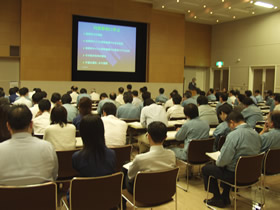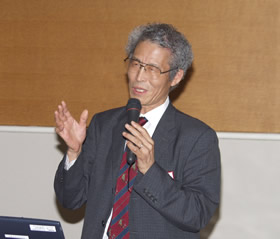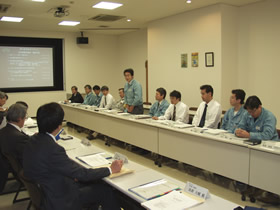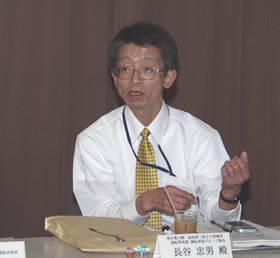|
|
 |
On 7, October 2004, the 65st Safety Caravan visit was held at Yokohama Engineering Center, Ishikawajima-Harima Heavy Industries Co., Ltd, located in Yokohama shi, Kanagawa Prefecture. |
Safety Presentation |
About 120 persons, including the employees of Yokohama Engineering Center and cooperating companies, attended the Safety Presentation. At the beginning of the Presentation, Mr. Iwama, General Manager of Nuclear Power Division, Ishikawajima-Harima Heavy Industries Co., Ltd, gave an address and said, “We almost finished the fabrication of BWRs that had been conducted as a project of the Nuclear Power Division, and will now maintain our techniques and know-how, placing top priority on quality the same as before. In this sense, we hope to promote our future corporate activities, utilizing information and comments obtained through the today’s seminars and safety information exchange sessions in the Safety Caravan of NSnet.”
|

|
|
Safety Presentation
|
After the address, Mr. Machida, Director Secretary-General of NSnet, introduced NSnet activities, and this was followed by a lecture entitled “ Power Reactor & Nuclear Fuel Development Corporation (PNC) to Japan Nuclear Cycle Development Institute (JNC), and then to Japan Nuclear Research & Development Institute Revolution for Safety Management ” delivered by Mr. Suzuki, Special Assistant to President, Japan Nuclear Cycle Development Institute |

|
|
Mr. Suzuki
|
In the lecture, he said, “We have made efforts for nuclear safety such as improvement and enhancement of safety management during a period of PNC to JNC.
There are no immediate and ultimate remedies for nuclear safety. Safety issues occur even if multiple defense-in various stages is provided. In addition, it is necessary to recognize that nuclear outsiders have different reactions to information, troubles and accidents from those involved in nuclear business.
Learning interior and exterior cases from PNC to JNC, we have improved and enhanced safety management, considering environmental changes such as ‘establishing a system in which a plant manager leads accident response, being supported by the headquarters, Tokyo Office,’ ‘defining ensured safety in management policies, establishing concrete policies for lower organizations and incorporating top safety audit and other safety activities into PDCA cycle,’ ‘reviewing manuals and procedures taking into account abnormal situations’ and ‘promoting a horizontal development to have all personnel aware of safety issues through comics.’
Under changing surroundings, such as aging facilities and equipment, generation change of human resources, reduced budget, established new corporations and emergencies including terrorist attacks, we have to encourage ‘established methods for rational safety management,’ ‘technological succession,’ ‘increased sensibility to dangers,’ ‘unity of our staff and cooperation company employees and promoted communication between them’ and ‘increased collaboration with various institutions and organizations.’
|
Safety information exchange session
|

|
|
Safety information exchange session
|
|
Introduction of Activities to Create a Safety Culture and Exchange of Opinions
|
In the Safety Information Exchange Session, “the use of ‘Qs and As’ session for identifying causes of human errors” selected as one of good practices by the Peer Review in the Fukushima Daini Nuclear Power Station, Tokyo Electric Power Company, Inc. (TEPCO), for which Ishikawajima-Harima Heavy Industries Co., Ltd. requested the introduction, was presented in detail by Mr. Tadao Hase, a manager for Plant Operation Assessment Group, Operation and Management Department of the Power Station, TEPCO.

|
Following are some excerpts of the main exchanges of information and opinions:
| ● |
How is the “Qs and As” session designed not so as to seek only human error sources? |
| ○ |
Certainly, it is difficult to do so. Since all human errors are not basically eliminated, I try to think about these issues from their standpoints and provide relaxed tone and atmosphere, focusing on the reason that the problems could not be blocked by organizations and mechanisms. |
| ○ |
First, priority is given to objective facts, for instance, logs, alarm records and access zone recording, and secondly, being supported by human memories. |
|
|
|
|







